ISIS Redux: The Central Syria Insurgency in July 2023
Following is the July 2023 installment of “ISIS Redux: The Central Syria Insurgency,” a monthly chronicle of attacks by the terrorist group ISIS in central Syria. A review of developments throughout 2022 and 2021 can be found here and here. The January 2023 edition can be found here, February’s here, March’s here, April’s here, May’s here, and June’s here. A full background and analysis of ISIS’s resurgence in Syria, including the methodology used to collect this data, can also be explored here, here, and here.
ISIS carried out at least 12 confirmed attacks in July in Homs, Hama, Raqqa, and Deir Ez Zor governorates. These attacks killed at least 16 pro-Assad regime soldiers and three civilians and wounded seven additional people. There were also three high quality* attacks during July. Overall, ISIS activity increased slightly compared to June, but stand in stark contrast to March and April, in which at least 187 people died in 75 confirmed attacks in central Syria. High quality attacks in July dropped compared to June, reflecting a generally more passive month dominated by attacks utilizing mines and improvised explosive devices (IED).
ISIS media took credit for two attacks in the Badia in July, while also claiming a July 27 IED attack in central Damascus. This was the second claimed ISIS attack in Damascus City this year, and the third since September 2021, when the group publicized its first attack in Damascus since being ousted from the southern suburbs in spring 2018. The most serious attack in July came on the last night of the month, when ISIS cells ambushed an oil tanker convoy on the highway connecting Hama with Raqqa, destroying six trucks and killing five soldiers. This was the first serious ISIS attack on a main highway convoy since January 2021. That attack and a similar one a week earlier in December triggered the widespread regime operations that have significantly dampened ISIS activity in central Syria since early 2021. This latest attack along Hama’s main east-west highway follows several months of gradually escalating ISIS activity in eastern Hama—as documented in ISIS Redux reports—mirroring in many ways ISIS’s expansion in early 2020.
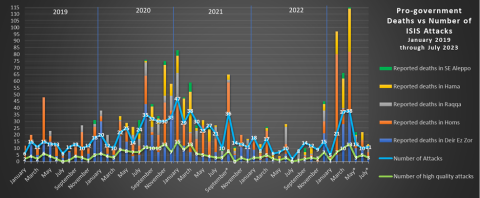
*Indicates an attack in Damascus City claimed by ISIS. Two additional IED attacks occurred in Homs City in June 2023 that went unclaimed but were suspected to be conducted by ISIS.
ISIS attacks dropped for the third month in a row in Homs (1), stayed stable in Deir Ez Zor (3) and increased in both Hama (5) and in southern Raqqa (3). No incidents were documented in Aleppo.
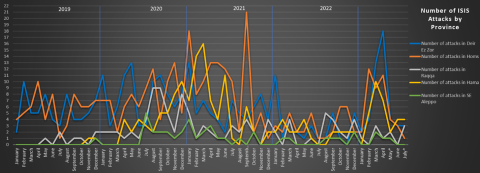
Deir Ez Zor and Raqqa
The number of ISIS attacks in Deir Ez Zor in April (18) was unprecedented, more than in any month since the beginning of the insurgency in 2018. A dramatic reversal was witnessed in May (4), June (3), and July (3). While most of the attacks in these months consisted of mines or IEDs—which would generally be considered a more passive style of attack—these incidents occurred within Deir Ez Zor’s urban centers, rather than in the desert where ISIS traditionally enjoys more freedom of movement.
On July 1, a member of the pro-regime Liwa al-Quds militia was killed by an IED near Shoula. On July 13, an ISIS cell attacked security forces and civilians in the Shumaytah Oil Field, just outside the villages north of Deir Ez Zor City. The next week, on July 22, two members of the regime’s local state security branch were killed in a small arms attack inside the nearby town of Tabni.
Three attacks were documented in southern Raqqa in July, matching the total number of attacks documented there between April and June. On July 16, two pro-regime militiamen were killed by a mine or IED while driving along the Resafa-Ithriya highway. On July 23, another regime soldier was reported killed somewhere in southern Raqqa. On July 28, suspected ISIS militants attacked a group of shepherds three kilometers south of Maadan. The attackers, which witnesses described as using three motorcycles and two pickups, killed and captured hundreds of sheep. One shepherd was kidnapped and later found executed. The attack is similar to dozens of attacks on shepherds in eastern Hama and western Deir Ez Zor in recent years.
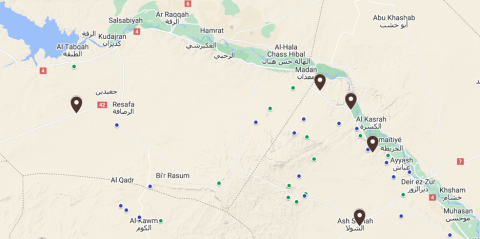
Map of locatable ISIS attacks in Dier Ez Zor and Raqqa (highlighted) in July 2023 alongside all other attacks in 2023. Not mapped is one attack that occurred somewhere in the Raqqa countryside.
Homs and Hama
April witnessed the end of the month-long regime offensive to secure al-Kawm, the strategic village in northeast Homs. While documented ISIS activity continued in this region through May and June, confirmed ISIS attacks in Homs dropped significantly in July. The only confirmed attack in Homs occurred on July 22, when four pro-regime fighters were killed by an IED east of Tuwaynan. ISIS claimed this attack several days later, though the group’s statement used exaggerated casualty numbers that appeared to be copied from opposition news networks.
Most ISIS activity in July occurred in east Hama, where the group has gradually been increasing its presence since February of this year. Mines and IEDs continue to kill civilians and security forces alike. A civilian was killed near Sa’an on July 5, while one soldier was killed and another wounded by a mine near Tel Salama on July 8. Tel Salama has been a focal point of ISIS activity in eastern Hama since February. On July 28, a child was severely wounded by a mine northeast of Salamiyah, while on the same day an oil worker was killed by an IED while exploring an oil field east of Uqayribat. This last attack was claimed by ISIS on July 31.
Hama’s biggest attack occurred on July 31, when ISIS cells launched an evening assault on an oil convoy traveling on the Hama-Raqqa highway near Wadi Azeeb. Five soldiers were killed and four wounded in the fighting. Six trucks were also destroyed. This is the most serious highway attack since the December 31, 2020 ambush of military vehicles near Shoula, Deir Ez Zor, and a smaller ambush of an oil convoy a week later, also near Wadi Azeeb.
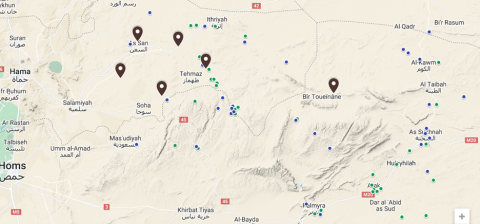
Map of locatable ISIS attacks in Homs and Hama (highlighted) in July 2023 alongside all other attacks in 2023.
Looking Ahead
Some new trends are beginning to solidify in ISIS’s 2023 Badia insurgency. Activity in Hama continues to gradually grow following more than a year of general malaise. Small arms attacks returned in February, followed by multiple attacks claimed in June—the first such claims by ISIS in east Hama in two years. The July 31 highway attack marked a further escalation. When ISIS first expanded into eastern Hama in mid-2020, most of the attacks were concentrated in the Tel Salama-Wadi Azeeb-Ithriya triangle—the same region now seeing consistent ISIS activity. The gradual return to 2020-style attacks in this same area this year suggests that ISIS has either re-activated or re-introduced cells to eastern Hama and is placing particular emphasis on conducting operations there. It should be noted that this area was—and possibly still is—a key financial hub for the group.
In Deir Ez Zor, suspected ISIS militants continue to conduct attacks inside the urban belt. While conducting only a small number of shootings and IED attacks each month, the expansion into what was for years a secure area is noteworthy. It is not clear, however, if this security issue will escalate into anything that threatens governance structures. More likely, ISIS’s decision to conduct attacks in these areas is indicative of a degree of general infiltration that is more focused on human, financial, and supply smuggling than direct confrontations.
Lastly, ISIS’s second IED attack in Damascus City since May should raise concerns about the extent of ISIS’s infiltration in the city. This author has long argued—based on conversations with regime officers overseeing anti-ISIS operations over the years—that part of the ISIS Badia strategy was to re-infiltrate Damascus and Homs cities. The IED attacks in the outskirts of Damascus in September 2021 marked the first ISIS attacks in the city since the group was ousted from its southern suburbs in spring 2018. May and July’s IED attacks bookend two additional unclaimed IED attacks in Homs City, both of which bear the hallmark of ISIS attacks in southern Syria. Altogether, the gradual escalations in the Badia combined with the consistent IED attacks in Homs and Damascus during the past three months may reflect a new strategy: Maintain a low level of pressure on regime forces in the desert that enables economic attacks (i.e. the attacks on the convoy and Shumaytah Oil Field) while directing resources towards insurgent cells in urban centers.
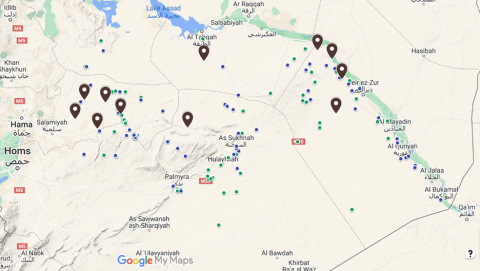
Map of locatable ISIS attacks (highlighted) in July 2023 alongside all other attacks in 2023 (green for Quarter 1 and blue for Quarter 2). Not shown is one attack somewhere in southern Raqqa. To view an interactive version of this map, please click here.
*High quality attacks are defined as attacks behind frontlines, those that result in seized positions, target regime officers, involve coordinated attacks on multiple positions, fake checkpoints, ambushes on military convoys, or attacks on checkpoints that kill at least three soldiers or lead to POWs.
Stay up to date on our latest news.
Get the latest news on extremism and counter-extremism delivered to your inbox.